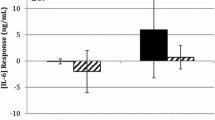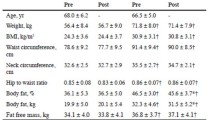Abstract
Background and aims
Elastic band exercise is considered as an effective and safe resistance type of exercise. However, there is a paucity of knowledge of the physiological effect of long-term elastic band exercise in the elderly. The purpose of this study was to examine the effects of a 12-week elastic band exercise program on body composition, physical fitness, anabolic hormones, and inflammatory cytokines in the elderly.
Methods
The subjects (aged 65–82 years) were randomly assigned into the exercise group (n = 18) or the control group (n = 22). Elastic band exercise session was performed for 60 min, three times per week for 12 weeks, during which various types of resistance exercises were assigned to the exercise group using red-colored bands. Body composition was analyzed using the biolelectrical impedance measurement. Senior fitness test was adopted to determine the level of physical fitness.
Results
After 12 weeks of band exercise program, body composition and all fitness components of senior fitness test were significantly improved in the exercise group compared to the control group. In contrast, blood lipid profiles (TC, TG, and HDL), anabolic hormones (GH, IGF-1 and IGFBP-3), and inflammatory cytokines (TNF-α, IL-1β, IL-6, and CRP) were not significantly changed in the exercise group compared to the control group.
Conclusions
Our results showed that elastic band exercise did not appear to positively impact on blood lipids, anabolic hormones, and inflammatory cytokines, but significantly improved body composition and overall physical fitness level in the elderly.
Similar content being viewed by others
References
Rosenberg IH (1989) Epidemiologic and methodologic problems in determining nutritional status of older persons. Proceedings of a conference. Albuquerque, New Mexico, October 19–21, 1988. Am J Clin Nutr 50:1121–1123
Iannuzzi-Sucich M, Prestwood KM, Kenny AM (2002) Prevalence of sarcopenia and predictors of skeletal muscle mass in healthy, older men and women. J Gerontol A Bio Sci Med Sci 57:772–777
Nair KS (2005) Aging muscle. Am J Clin Nutr 81:953–963
Roubenoff R, Parise H, Payette HA, Abad LW, D’Agostino R, Jacques PF, Wilson PW, Dinarello CA, Harris TB (2003) Cytokines, insulin-like growth factor 1, sarcopenia, and mortality in very old community-dwelling men and women: the Framingham Heart Study. Am J Med 115(6):429–435
Visser M, Schaap LA (2011) Consequences of sarcopenia. Clin Geriatr Med 27(3):387–399
Taaffe DR (2006) Sarcopenia: exercise as a treatment strategy. Aust Fam Physician 35:130–133
Mulsant BH, Ganguli M, Seaberg EC (1997) The relationship between self-rated health and depressive symptoms in an epidemiological sample of community dwelling older adults. J Am Geriatr Soc 45:954–958
Borst SE (2004) Interventions for sarcopenia and muscle weakness in older people. Age Ageing 33:548–555
Izquierdo M, Ibanez J, Hakkinen K, Kraemer WJ, Larrion JL, Gorostiaga EM (2004) Once weekly combined resistance and cardiovascular training in healthy older men. Med Sci Sports Exerc 36:435–443
Sipilä S, Suominen H (2005) Effects of strength and endurance training on thigh and leg muscle mass and composition in elderly women. J Appl Physiol 78:334–340
Hagerman FC, Fielding RA, Fiatarone MA, Gault JA, Kirkendall DT, Ragg KE (1996) A 20-year longitudinal study of Olympic oarsmen. Med Sci Sports Exerc 28:1150–1156
Kerr ZY, Collins CL, Comstock RD (2010) Epidemiology of weight training-related injuries presenting to United States emergency departments, 1990 to 2007. Am J Sports Med 38(4):765–771
Lavallee ME, Balam T (2010) An overview of strength training injuries: acute and chronic. Curr Sports Med Rep 9(5):307–313
Liu CJ, Latham N (2010) Adverse events reported in progressive resistance strength training trials in older adults: 2 sides of a coin. Arch Phys Med Rehabil 91(9):1471–1473
Colado JC, Garcia-Masso X, Pellicer M, Alakhdar Y, Benavent J, Cabeza-Ruiz R (2010) A comparison of elastic tubing and isotonic resistance exercise. Int J Sports Med 31(11):810–817
Phillip P, Todd SE (2003) The scientific and clinical application of elastic resistance. Hum Kinetics
Häkkinen K, Pakarinen A, Kraemer WJ, Newton RU, Alen M (2000) Basal concentrations and acute responses of serum hormones and strength development during heavy resistance training in middle-aged and elderly men and women. J Gerontol A Bio Sci Med Sci 55:B95–B105
Kraemer WJ, Häkkinen K, Newton RU, Nindl BC, Volek JS, McCormick M, Gotshalk LA et al (1999) Effects of heavy-resistance training on hormonal response patterns in younger vs. older men. J Appl Physiol 87:982–992
McCall GE, Byrnes WC, Fleck SJ, Dickinson A, Kraemer WJ (1999) Acute and chronic hormonal responses to resistance training designed to promote muscle hypertrophy. Can J Appl Physiol 24:96–107
Kraemer WJ, Ratamess NA (2005) Hormonal responses and adaptations to resistance exercise and training. Sports Med 35:339–361
Beyer I, Mets T, Bautmans I (2011) Chronic low-grade inflammation and age-related sarcopenia. Curr Opin Clin Nutr Metab Care [Epub ahead of print]
Petersen AM, Pedersen BK (2005) The anti-inflammatory effect of exercise. J Appl Physiol 98(4):1154–1162
Cho YG, Kang JH, Kim KA (2007) Comparison of bioelectrical impedance analysis with dual energy X-ray absorptiometry in obese women. Korean J Obes 16(2):50–57
Rikli RE, Jones CJ (2001) Senior fitness test manual. Hum Kinetics
Sillanpää E, Häkkinen A, Nyman K, Mattila M, Cheng S, Karavirta L, Laaksonen DE et al (2008) Body composition and fitness during strength and/or endurance training in older men. Med Sci Sports Exer 40:950–958
Ku YH, Han KA, Ahn H, Kwon H, Koo BK, Kim HC, Min KW (2010) Resistance exercise did not alter intramuscular adipose tissue but reduced retinol-binding protein-4 concentration in individuals with type 2 diabetes mellitus. J Int Med Res 38(3):782–791
Galvão DA, Taaffe DR (2005) Resistance exercise dosage in older adults: single versus multi set effects on physical performance and body composition. J Am Geriatr Soc 53(12):2090–2097
Egaña M, Reilly H, Green S (2010) Effect of elastic-band-based resistance training on leg blood flow in elderly women. Appl Physiol Nutr Metab 35(6):763–772
Rogers ME, Sherwood HS, Rogers NL, Bohlken RM (2002) Effects of dumbbell and elastic band training on physical function in older inner-city African-American women. Women Health 36(4):33–41
Krebs DE, Jette AM, Assmann SF (1998) Moderate exercise improves gait stability in disabled elders. Arch Phys Med Rehabil 79(12):1489–1495
Kim KB, Lim KI, So WY, Park SK, Song W (2007) A meta-analysis of the effects of exercise therapy applied in obesity studies. Korean J Obes 16:177–185
Manning JM, Dooly-Manning CR, White K, Kampa I, Silas S, Kesselhaut M, Ruoff M (1991) Effects of a resistive training program on lipoprotein-lipid levels in obese women. Med Sci Sports Exerc 23(11):1222–1226
Hurley BF (1989) Effects of resistive training on lipoprotein-lipid profiles: a comparison to aerobic exercise training. Med Sci Sports Exerc 21(6):689–693
Durstine JL, Grandjean PW, David PG, Ferguson MA, Alderson NL, DuBose KD (2001) Blood lipid and lipoprotein adaptations to exercise: a quantitative analysis. Sports Med 31(15):1033–1062
Ahtiainen JP, Pakarinen A, Alen M, Kraemer WJ, Häkkinen K (2003) Muscle hypertrophy, hormonal adaptations and strength development during strength training in strength-trained and untrained men. Eur J Appl Physiol 89:555–563
Roubenoff R (2003) Catabolism of aging: is it an inflammatory process? Curr Opin Clin Nutr Met Care 6:295–299
Calabró P, Willerson JT, Yeh ET (2003) Inflammatory cytokines stimulated C-reactive protein production by human coronary artery smooth muscle cells. Circulation 108:1930–1932
Goldhammer E, Tanchilevitch A, Maor I, Beniamini Y, Rosenschein U, Sagiv M (2005) Exercise training modulates cytokines activity in coronary heart disease patients. Int J Cardiol 100:93–99
Kohut ML, McCann DA, Russell DW, Konopka DN, Cunnick JE, Franke WD, Castillo MC et al (2006) Aerobic exercise, but not flexibility/resistance exercise, reduces serum IL-18, CRP, and IL-6 independent of beta-blockers, BMI, and psychosocial factors in older adults. Brain Behav Immun 20:201–209
Mattusch F, Dufaux B, Heine O, Mertens I, Rost R (2000) Reduction of the plasma concentration of C-reactive protein following nine months of endurance training. Int J Sports Med 21:21–24
Hammett CJ, Prapavessis H, Baldi JC, Varo N, Schoenbeck U, Ameratunga R, French JK et al (2006) Effects of exercise training on 5 inflammatory markers associated with cardiovascular risk. Am Heart J 151:367.e7–367.e16
Marcell TJ, McAuley KA, Traustadóttir T, Reaven PD (2005) Exercise training is not associated with improved levels of C-reactive protein or adiponectin. Metabolism 54:533–541
Nicklas BJ, Ambrosius W, Messier SP, Miller GD, Penninx BW, Loeser RF, Palla S et al (2004) Diet-induced weight loss, exercise, and chronic inflammation in older, obese adults: a randomized controlled clinical trial. Am J Clin Nutr 79:544–551
Acknowledgments
The authors would like to express sincere thanks to all of subjects for their participation. This work was supported by the KRF-2007-314-E00209 and Bio & Medical Technology Development Program (MEST, 2011-0030133) of the National Research Foundation funded by the Korean government.
Conflict of interest
None.
Author information
Authors and Affiliations
Corresponding author
Rights and permissions
About this article
Cite this article
So, Wy., Song, M., Park, Yh. et al. Body composition, fitness level, anabolic hormones, and inflammatory cytokines in the elderly: a randomized controlled trial. Aging Clin Exp Res 25, 167–174 (2013). https://doi.org/10.1007/s40520-013-0032-y
Received:
Accepted:
Published:
Issue Date:
DOI: https://doi.org/10.1007/s40520-013-0032-y




